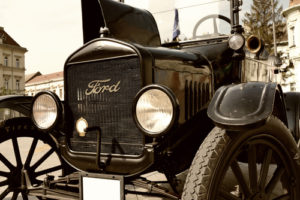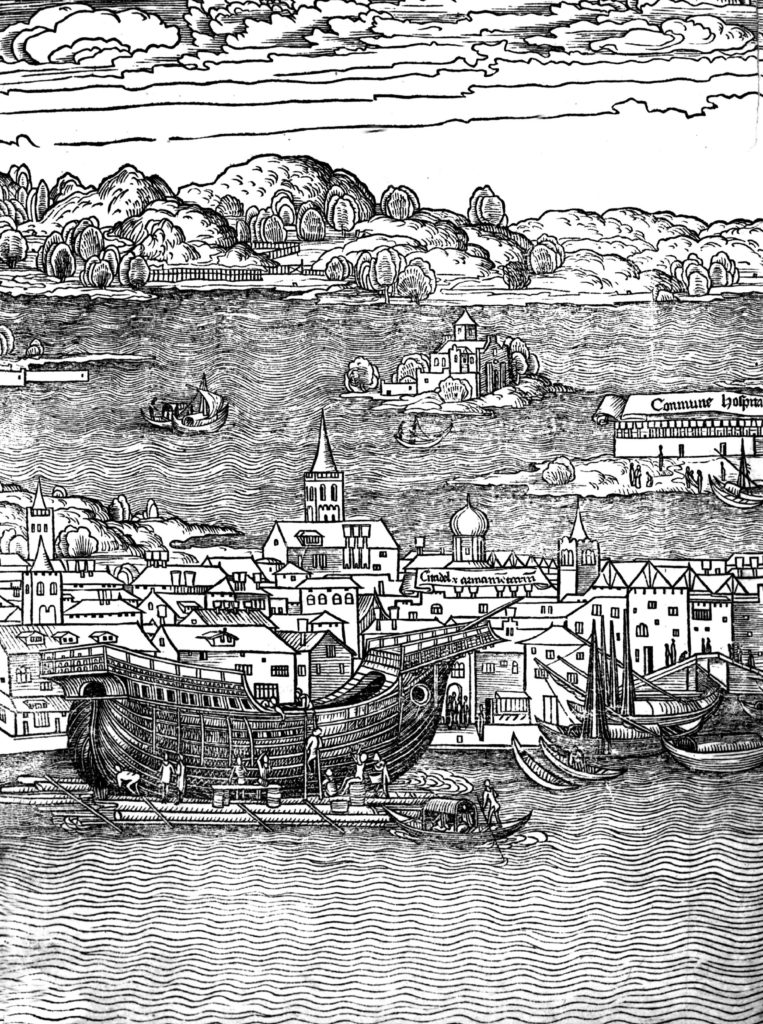By the end of 1918, half of the cars owned in the United States were Ford Model T’s. All were painted black. By the time the last car rolled off the assembly line in 1927 it is estimated that there had been over 15,000,000 Model T’s produced by Ford. Few people in history have impacted the  trajectory of modern American culture as profoundly as Henry Ford. He was inarguably a genius in terms of both marketing and manufacturing. Known by many as the “Father of Manufacturing”, he is often credited for being the inventor of the assembly line. Though he may have been the first to bring “automation” to an assembly line, he was not the first to put the overall “line” concept to use. In 1902, Ransom Olds, the son of an Ohio blacksmith, was mass producing his Oldsmobile Curved Dash automobile. By 1905 Olds was manufacturing 5,000 cars a year. Ford would not introduce the Model T until 1908. Even as groundbreaking as Olds ideas were, he was far form the first person to use an assembly line. A similar idea had been implemented hundreds of years before Olds had even been born.
trajectory of modern American culture as profoundly as Henry Ford. He was inarguably a genius in terms of both marketing and manufacturing. Known by many as the “Father of Manufacturing”, he is often credited for being the inventor of the assembly line. Though he may have been the first to bring “automation” to an assembly line, he was not the first to put the overall “line” concept to use. In 1902, Ransom Olds, the son of an Ohio blacksmith, was mass producing his Oldsmobile Curved Dash automobile. By 1905 Olds was manufacturing 5,000 cars a year. Ford would not introduce the Model T until 1908. Even as groundbreaking as Olds ideas were, he was far form the first person to use an assembly line. A similar idea had been implemented hundreds of years before Olds had even been born.
In 1100, Venice began constructing the Arsenal shipyard. By 1320, it had become the worlds most advanced shipyard. Employing no less than 16,000 people, the Arsenal was fully capable of producing either a fully outfitted merchant or military vessel almost every single day. Elsewhere in Europe, during this same time period, it was not unusual for similar sized ship construction to take months or even years. Sprawling for hundreds of acres, mostly shorelines and nearly 20% of Venice, the world had never seen anything like it before. Miles and miles of canals and waterways devoted to nothing except mass producing the best, most well equipped ships in the world. Even to todays standards the amount of forethought and coordination is impressive. A secret to their unrivaled speed and efficiency was standardization. Standardization of parts was a new concept at this time. Before this, almost everything created was done by hand, usually by the person that would use the tool, live in the house, sail on the ship, etc… Due to this, it took longer for things to be built and even longer for things to be repaired.
At the Arsenal there were three main stages to each ship construction: framing, planking and cabins, and final assembly. Craftsman had found that they could easily coordinate with other teams on projects requiring hundreds of other workers if they knew what the other teams would be doing. In England, ship construction still relied heavily on a flawed guild system. At the Arsenal, teams of craftsman could simultaneously be working on different sections of the ships completely independent of each other. Tolerances were likely very tight, and precision was necessary for the mass production concept to work properly, but after years and years the process was as close to perfect as it could have ever been. As the ships were being built they would be pulled slowly down various canals and reservoirs until the construction was complete, the ship was outfitted, and then finally sent out to sea. The Arsenal never slept. Work never stopped. Crews of laborers and craftsman moved in and out twenty four hours a day. Supply lines carrying raw material such as wood and iron snaked out from the yard. Incidentally, the Arsenal Shipyards became the heart of Europe’s firearm and rope production for many years. By 1450, Venice had a navy consisting of over 3,000 ships and dominated Mediterranean commerce. Due to the Arsenal, Venice remained militarily and economically relevant for hundreds of years until it fell to Napoleons conquest of the area 1797.
Since the time of the Venetian Arsenal we have seen many, many, advancements in manufacturing. We have seen groundbreaking innovations and watch as jaw dropping technologies are developed. For good or ill, people like Elon Musk, Steve Jobs, and Tony Stark have helped shaped the road that leads us towards wherever we are headed. As we go down that road it may be important for us to remember that many of the amazing advancements we think of as relatively “modern” ideas may not be all that modern at all.
Be sure to visit us online at www.gesrepair.com or call us at 1-877-249-1701 to learn more about our services. We’re proud to offer Surplus, Complete Repair and Maintenance on all types of Industrial Electronics, Servo Motors, AC and DC Motors, Hydraulics and Pneumatics. Please subscribe to our YouTube page and Like Us on Facebook! Thank you
